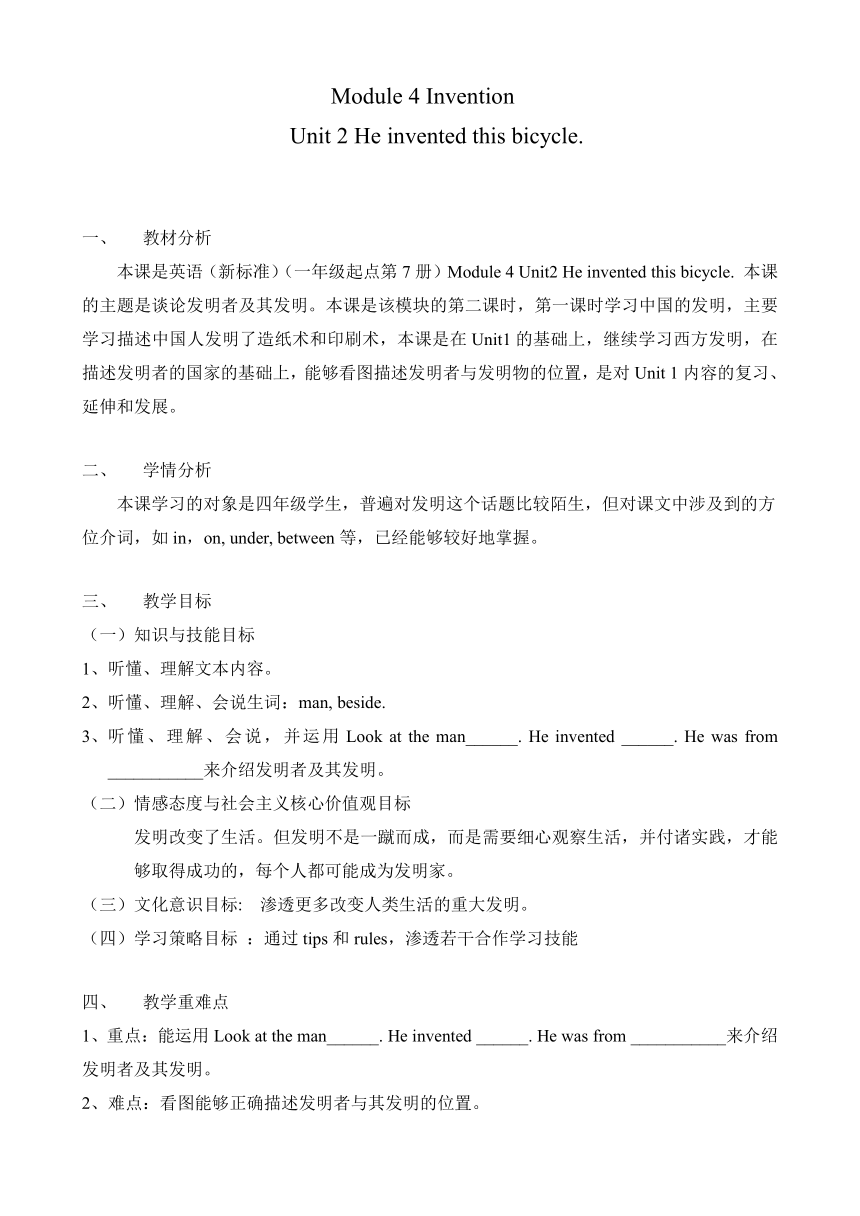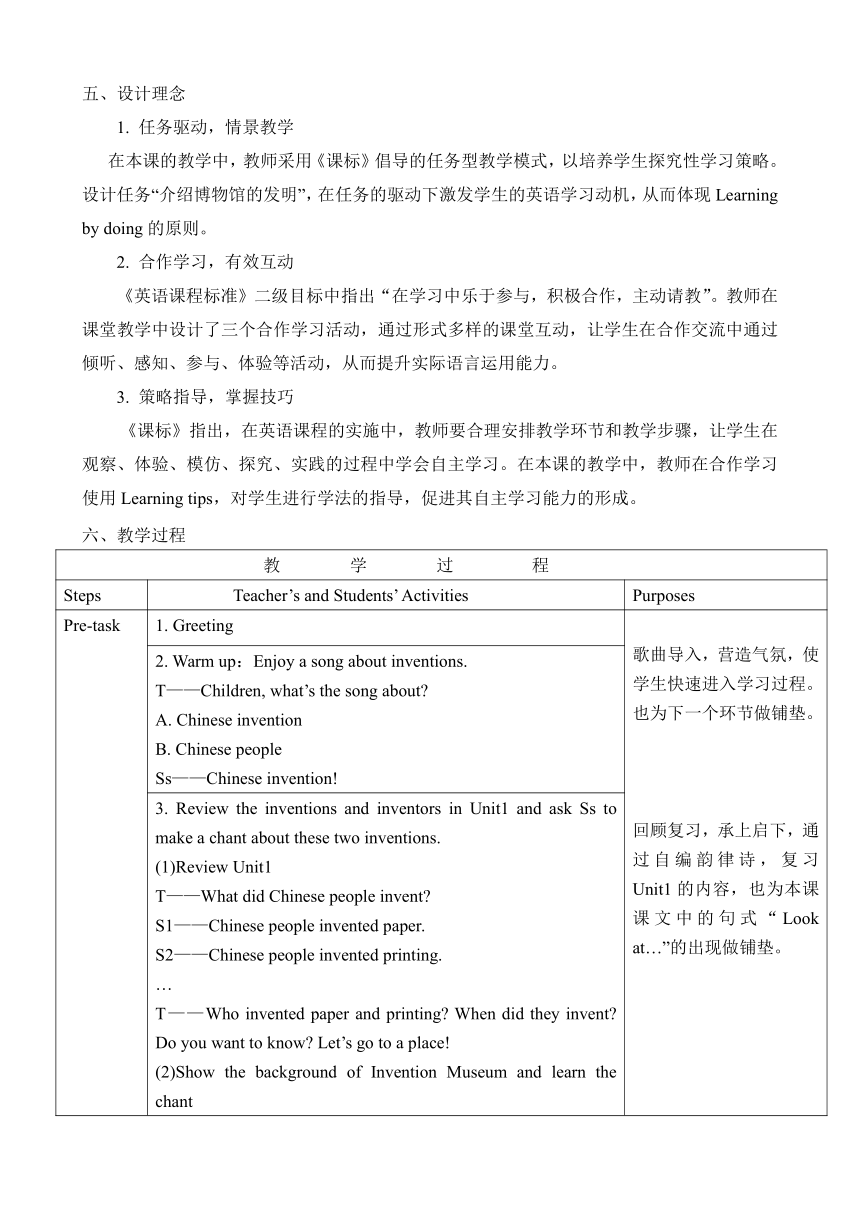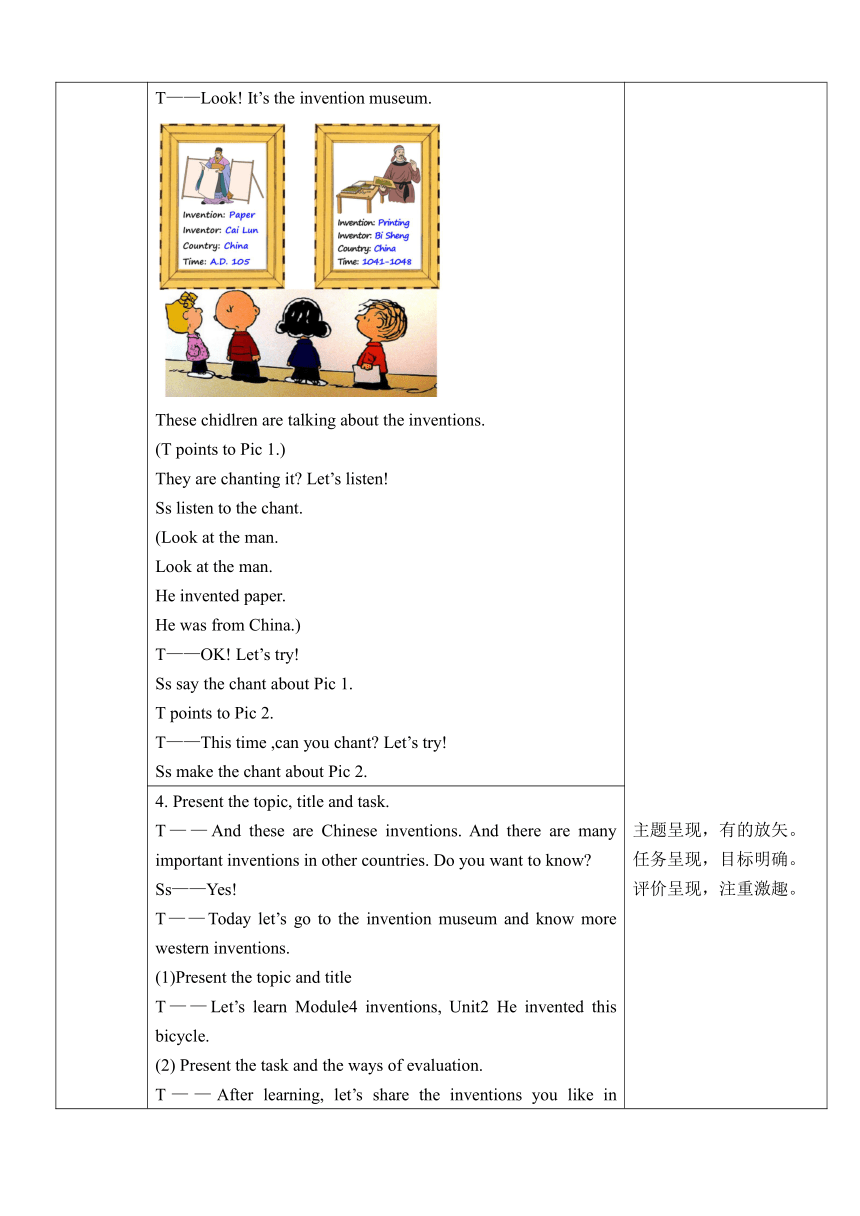外研版(一起)四上 Module 4 Unit 2 He invented this bicycle教案(表格式)
文档属性
| 名称 | 外研版(一起)四上 Module 4 Unit 2 He invented this bicycle教案(表格式) |

|
|
| 格式 | doc | ||
| 文件大小 | 1.9MB | ||
| 资源类型 | 教案 | ||
| 版本资源 | 外研版(一年级起点) | ||
| 科目 | 英语 | ||
| 更新时间 | 2021-08-05 10:42:57 | ||
图片预览



文档简介
Module 4 Invention
Unit 2 He invented this bicycle.
教材分析
本课是英语(新标准)(一年级起点第7册)Module 4 Unit2 He invented this bicycle. 本课
的主题是谈论发明者及其发明。本课是该模块的第二课时,第一课时学习中国的发明,主要学习描述中国人发明了造纸术和印刷术,本课是在Unit1的基础上,继续学习西方发明,在描述发明者的国家的基础上,能够看图描述发明者与发明物的位置,是对Unit 1内容的复习、延伸和发展。
学情分析
本课学习的对象是四年级学生,普遍对发明这个话题比较陌生,但对课文中涉及到的方
位介词,如in,on, under, between等,已经能够较好地掌握。
教学目标
知识与技能目标
听懂、理解文本内容。
听懂、理解、会说生词:man, beside.
听懂、理解、会说,并运用Look at the man______. He invented ______. He was from ___________来介绍发明者及其发明。
情感态度与社会主义核心价值观目标
发明改变了生活。但发明不是一蹴而成,而是需要细心观察生活,并付诸实践,才能够取得成功的,每个人都可能成为发明家。
文化意识目标: 渗透更多改变人类生活的重大发明。
学习策略目标 :通过tips和rules,渗透若干合作学习技能
教学重难点
1、重点:能运用Look at the man______. He invented ______. He was from ___________来介绍发明者及其发明。
2、难点:看图能够正确描述发明者与其发明的位置。
五、设计理念
1. 任务驱动,情景教学
在本课的教学中,教师采用《课标》倡导的任务型教学模式,以培养学生探究性学习策略。设计任务“介绍博物馆的发明”,在任务的驱动下激发学生的英语学习动机,从而体现Learning by doing的原则。
2. 合作学习,有效互动
《英语课程标准》二级目标中指出“在学习中乐于参与,积极合作,主动请教”。教师在课堂教学中设计了三个合作学习活动,通过形式多样的课堂互动,让学生在合作交流中通过倾听、感知、参与、体验等活动,从而提升实际语言运用能力。
3. 策略指导,掌握技巧
《课标》指出,在英语课程的实施中,教师要合理安排教学环节和教学步骤,让学生在
观察、体验、模仿、探究、实践的过程中学会自主学习。在本课的教学中,教师在合作学习使用Learning tips,对学生进行学法的指导,促进其自主学习能力的形成。
六、教学过程
教 学 过 程
Steps Teacher’s and Students’ Activities Purposes
Pre-task 1. Greeting
歌曲导入,营造气氛,使学生快速进入学习过程。也为下一个环节做铺垫。
回顾复习,承上启下,通过自编韵律诗,复习Unit1的内容,也为本课课文中的句式“Look at…”的出现做铺垫。
主题呈现,有的放矢。
任务呈现,目标明确。
评价呈现,注重激趣。
2. Warm up:Enjoy a song about inventions.
T——Children, what’s the song about?
A. Chinese invention
B. Chinese people
Ss棗Chinese invention!
3. Review the inventions and inventors in Unit1 and ask Ss to make a chant about these two inventions.
(1)Review Unit1
T棗What did Chinese people invent?
S1棗Chinese people invented paper.
S2棗Chinese people invented printing.
T棗Who invented paper and printing? When did they invent? Do you want to know? Let抯 go to a place!
(2)Show the background of Invention Museum and learn the chant
T棗Look! It抯 the invention museum.
These chidlren are talking about the inventions.
(T points to Pic 1.)
They are chanting it? Let抯 listen!
Ss listen to the chant.
(Look at the man.
Look at the man.
He invented paper.
He was from China.)
T棗OK! Let抯 try!
Ss say the chant about Pic 1.
T points to Pic 2.
T棗This time ,can you chant? Let抯 try!
4. Present the topic, title and task.
T棗And these are Chinese inventions. And there are many important inventions in other countries. Do you want to know?
Ss棗Yes!
T棗Today let抯 go to the invention museum and know more western inventions.
(1)Present the topic and title
T——Let’s learn Module4 inventions, Unit2 He invented this bicycle.
(2) Present the task and the ways of evaluation.
T——After learning, let’s share the inventions you like in groups.(在组内交流你喜欢的发明)
While-task Task 1:Know the car and its inventor
1. Watch and choose:
T——In unit1, we knowed that Chinese people invented many important things. And foreigners invented many important things, too. Look at the man, what did he invent? Where was he from? Let抯 watch and choose.
Ss watch.
2. Check and talk about the car and inventor.
3. Know more about the inventor.
T棗We抳e talked about this man and these cars. Who was he? When did he invent? Let抯 know more about it.
His name was Henry Ford. He invented these cars in 1896.
从文本学习中梳理句型,
Task 2:Know the bicycle and its inventor
1. Read and write
T——What about this man? What did he invent? This time, let’s read and answer.
What did the man invent? He invented ___________.
Where was he from? He was from ___________.
(Ask Ss to underline the key words.)
2. Check and talk about the bicycle and inventor.
3. Know more about the inventor.
4. Listen and imitate.
通过任务一归纳出来的句型,自行阅读文本,寻找关键信息。
Task 3: Know the evolution of bicycles and their inventors
1. Watch a vedio about the evolution of bicycles
T——Look at the bicycle. The man invented this bicycle. What about other bicycles? Do you want to know? Let’s watch.
2. Ask Ss to work in pairs and choose the bicycles they like to introduce.
Use the sentence:
Look at the man ______ the bicycle.
He invented this bicycle.
He was from __________.
3. Ask some Ss to talk about the bicycles they like in class.
4. Emotional Education
自行车的发明者在生活中认真观察,并且将想法付诸实践,不断改进,才会有今天最便捷的自行车。 运用语言,巩固所学。
在此环节呈现更多的方位介词,鼓励学生多说,活动中关注个体差异,并进行人文渗透。
Task 4:Introduce an invention you like.
1. T presents a brochure of invention museum.
T——We’ve learnt some inventions today. Do you want to know more inventions? I bring you the brochure of invention museum. In the brochure, there are many inventions. Do you want to have a look?
2. Ask Ss to read the brochure in groups of four.
3. Choose one invention to talk. 引导学生综合运用语言,并满足不同层次学生的需求,实现学以致用。
Post-task 1.Sum up
2.Emotional Education
T——What do you want to invent?
Ss free talk.
T——Try your best. And you will be the next inventor. Just do it!
3. Assignment
(1) Review the text.
(2) Surf the internet and know more about the invention you like.
人文素养渗透
分层作业,读写娱乐结合。
七、教学反思
本课选自外研社一起四年级上册Module4Unit2 He invented this bicycle.
本课的主题是Invention,本课既要谈论Invention,又要谈论方位。基于这样的教学目标,教师将本课的大背景设置为发明博物馆。从导入环节的图片呈现,就开始用”Look at the man”的句子结构,让谈论图片的句型呈现得更为自然,并将方位词融入到每张图片的介绍中。
本节课的教学设计环环相扣,步步深入。由歌曲复习旧知导入中国发明,设计听说活动一,看图介绍中国的两大发明。这部分既复习了旧知,又为新知做铺垫。通过复习,自编chant,从中国的发明过度到西方发明,引出课题及任务。接着进入文本的学习。教师将本课的文本学习分为两部分,先看课本动画,了解car的发明后,引出本课的句型结构,让学生自学bicycle及其他发明者的介绍,在文本中划出关键信息,并在组内操练。之后通过自行车的发展史,引入听说活动二,谈论不同款式的自行车及其发明者。在了解中西方发明的基础上,设计听说活动三,在组内阅读博物馆的介绍册子,介绍自己喜欢的发明,最后将学习延伸至课外,让学生上网查询更多自己想要了解的发明。
Unit 2 He invented this bicycle.
教材分析
本课是英语(新标准)(一年级起点第7册)Module 4 Unit2 He invented this bicycle. 本课
的主题是谈论发明者及其发明。本课是该模块的第二课时,第一课时学习中国的发明,主要学习描述中国人发明了造纸术和印刷术,本课是在Unit1的基础上,继续学习西方发明,在描述发明者的国家的基础上,能够看图描述发明者与发明物的位置,是对Unit 1内容的复习、延伸和发展。
学情分析
本课学习的对象是四年级学生,普遍对发明这个话题比较陌生,但对课文中涉及到的方
位介词,如in,on, under, between等,已经能够较好地掌握。
教学目标
知识与技能目标
听懂、理解文本内容。
听懂、理解、会说生词:man, beside.
听懂、理解、会说,并运用Look at the man______. He invented ______. He was from ___________来介绍发明者及其发明。
情感态度与社会主义核心价值观目标
发明改变了生活。但发明不是一蹴而成,而是需要细心观察生活,并付诸实践,才能够取得成功的,每个人都可能成为发明家。
文化意识目标: 渗透更多改变人类生活的重大发明。
学习策略目标 :通过tips和rules,渗透若干合作学习技能
教学重难点
1、重点:能运用Look at the man______. He invented ______. He was from ___________来介绍发明者及其发明。
2、难点:看图能够正确描述发明者与其发明的位置。
五、设计理念
1. 任务驱动,情景教学
在本课的教学中,教师采用《课标》倡导的任务型教学模式,以培养学生探究性学习策略。设计任务“介绍博物馆的发明”,在任务的驱动下激发学生的英语学习动机,从而体现Learning by doing的原则。
2. 合作学习,有效互动
《英语课程标准》二级目标中指出“在学习中乐于参与,积极合作,主动请教”。教师在课堂教学中设计了三个合作学习活动,通过形式多样的课堂互动,让学生在合作交流中通过倾听、感知、参与、体验等活动,从而提升实际语言运用能力。
3. 策略指导,掌握技巧
《课标》指出,在英语课程的实施中,教师要合理安排教学环节和教学步骤,让学生在
观察、体验、模仿、探究、实践的过程中学会自主学习。在本课的教学中,教师在合作学习使用Learning tips,对学生进行学法的指导,促进其自主学习能力的形成。
六、教学过程
教 学 过 程
Steps Teacher’s and Students’ Activities Purposes
Pre-task 1. Greeting
歌曲导入,营造气氛,使学生快速进入学习过程。也为下一个环节做铺垫。
回顾复习,承上启下,通过自编韵律诗,复习Unit1的内容,也为本课课文中的句式“Look at…”的出现做铺垫。
主题呈现,有的放矢。
任务呈现,目标明确。
评价呈现,注重激趣。
2. Warm up:Enjoy a song about inventions.
T——Children, what’s the song about?
A. Chinese invention
B. Chinese people
Ss棗Chinese invention!
3. Review the inventions and inventors in Unit1 and ask Ss to make a chant about these two inventions.
(1)Review Unit1
T棗What did Chinese people invent?
S1棗Chinese people invented paper.
S2棗Chinese people invented printing.
T棗Who invented paper and printing? When did they invent? Do you want to know? Let抯 go to a place!
(2)Show the background of Invention Museum and learn the chant
T棗Look! It抯 the invention museum.
These chidlren are talking about the inventions.
(T points to Pic 1.)
They are chanting it? Let抯 listen!
Ss listen to the chant.
(Look at the man.
Look at the man.
He invented paper.
He was from China.)
T棗OK! Let抯 try!
Ss say the chant about Pic 1.
T points to Pic 2.
T棗This time ,can you chant? Let抯 try!
4. Present the topic, title and task.
T棗And these are Chinese inventions. And there are many important inventions in other countries. Do you want to know?
Ss棗Yes!
T棗Today let抯 go to the invention museum and know more western inventions.
(1)Present the topic and title
T——Let’s learn Module4 inventions, Unit2 He invented this bicycle.
(2) Present the task and the ways of evaluation.
T——After learning, let’s share the inventions you like in groups.(在组内交流你喜欢的发明)
While-task Task 1:Know the car and its inventor
1. Watch and choose:
T——In unit1, we knowed that Chinese people invented many important things. And foreigners invented many important things, too. Look at the man, what did he invent? Where was he from? Let抯 watch and choose.
Ss watch.
2. Check and talk about the car and inventor.
3. Know more about the inventor.
T棗We抳e talked about this man and these cars. Who was he? When did he invent? Let抯 know more about it.
His name was Henry Ford. He invented these cars in 1896.
从文本学习中梳理句型,
Task 2:Know the bicycle and its inventor
1. Read and write
T——What about this man? What did he invent? This time, let’s read and answer.
What did the man invent? He invented ___________.
Where was he from? He was from ___________.
(Ask Ss to underline the key words.)
2. Check and talk about the bicycle and inventor.
3. Know more about the inventor.
4. Listen and imitate.
通过任务一归纳出来的句型,自行阅读文本,寻找关键信息。
Task 3: Know the evolution of bicycles and their inventors
1. Watch a vedio about the evolution of bicycles
T——Look at the bicycle. The man invented this bicycle. What about other bicycles? Do you want to know? Let’s watch.
2. Ask Ss to work in pairs and choose the bicycles they like to introduce.
Use the sentence:
Look at the man ______ the bicycle.
He invented this bicycle.
He was from __________.
3. Ask some Ss to talk about the bicycles they like in class.
4. Emotional Education
自行车的发明者在生活中认真观察,并且将想法付诸实践,不断改进,才会有今天最便捷的自行车。 运用语言,巩固所学。
在此环节呈现更多的方位介词,鼓励学生多说,活动中关注个体差异,并进行人文渗透。
Task 4:Introduce an invention you like.
1. T presents a brochure of invention museum.
T——We’ve learnt some inventions today. Do you want to know more inventions? I bring you the brochure of invention museum. In the brochure, there are many inventions. Do you want to have a look?
2. Ask Ss to read the brochure in groups of four.
3. Choose one invention to talk. 引导学生综合运用语言,并满足不同层次学生的需求,实现学以致用。
Post-task 1.Sum up
2.Emotional Education
T——What do you want to invent?
Ss free talk.
T——Try your best. And you will be the next inventor. Just do it!
3. Assignment
(1) Review the text.
(2) Surf the internet and know more about the invention you like.
人文素养渗透
分层作业,读写娱乐结合。
七、教学反思
本课选自外研社一起四年级上册Module4Unit2 He invented this bicycle.
本课的主题是Invention,本课既要谈论Invention,又要谈论方位。基于这样的教学目标,教师将本课的大背景设置为发明博物馆。从导入环节的图片呈现,就开始用”Look at the man”的句子结构,让谈论图片的句型呈现得更为自然,并将方位词融入到每张图片的介绍中。
本节课的教学设计环环相扣,步步深入。由歌曲复习旧知导入中国发明,设计听说活动一,看图介绍中国的两大发明。这部分既复习了旧知,又为新知做铺垫。通过复习,自编chant,从中国的发明过度到西方发明,引出课题及任务。接着进入文本的学习。教师将本课的文本学习分为两部分,先看课本动画,了解car的发明后,引出本课的句型结构,让学生自学bicycle及其他发明者的介绍,在文本中划出关键信息,并在组内操练。之后通过自行车的发展史,引入听说活动二,谈论不同款式的自行车及其发明者。在了解中西方发明的基础上,设计听说活动三,在组内阅读博物馆的介绍册子,介绍自己喜欢的发明,最后将学习延伸至课外,让学生上网查询更多自己想要了解的发明。
同课章节目录
- Module 1
- Unit 1 It was my birthday on Saturday.
- Unit 2 I've got a new friend .
- Module 2
- Unit 1 I helped my mum.
- Unit 2 Amy painted a picture.
- Module 3
- Unit 1 She didn't walk to school yesterday.
- Unit 2 I didn't play football.
- Module 4
- Unit 1 Chinese people invented paper.
- Unit 2 He invented this bicycle in 1839.
- Module 5
- Unit 1 We went to the Great Wall.
- Unit 2 I wore warm clothes.
- Module 6
- Unit 1 It didn't become gold.
- Unit 2 He didn't come back.
- Module 7
- Unit 1 Did you take Amy's doll?
- Unit 2 Did you see it?
- Module 8
- Unit 1 When did they come?
- Unit 2 Where did you go yesterday?
- Module 9
- Unit 1 What happened to your head?
- Unit 2 I bumped my head.
- Module 10
- Unit 1 Go to bed early.
- Unit 2 Eat vegetables every day.
- Review Module
- Unit 1
- Unit 2
